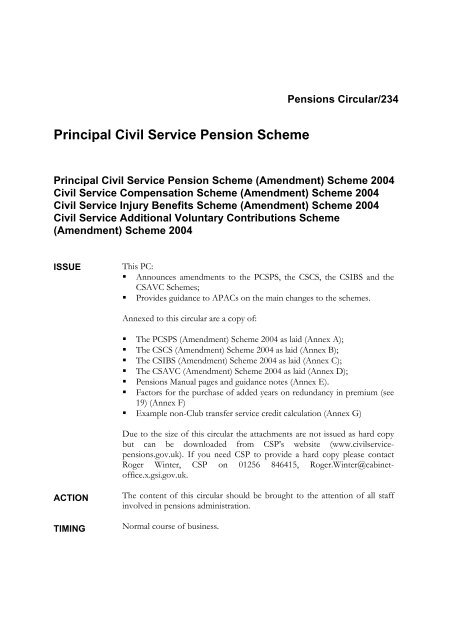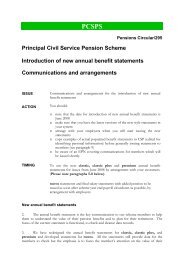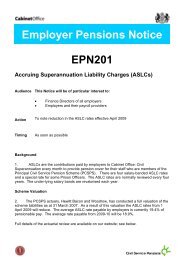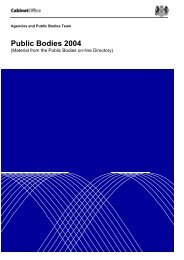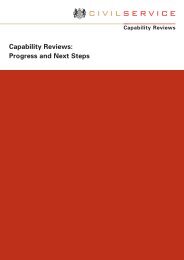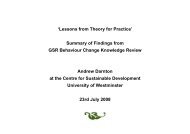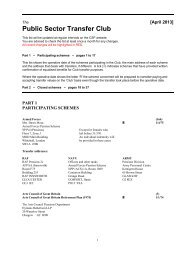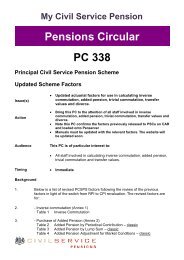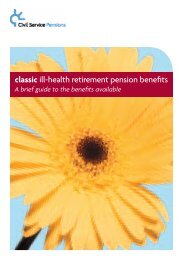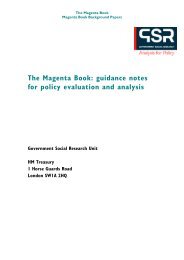Principal Civil Service Pension Scheme - The Civil Service
Principal Civil Service Pension Scheme - The Civil Service
Principal Civil Service Pension Scheme - The Civil Service
Create successful ePaper yourself
Turn your PDF publications into a flip-book with our unique Google optimized e-Paper software.
service to be considered for injury benefit and, if successful, now have benefit paid from the dayafter their last day in service.24. Those who are dismissed for disciplinary reasons can, as previously, only be paid injurybenefit when they reach pension age. <strong>The</strong> rule changes specify that those resigning wheredisciplinary proceedings are pending against them may also only be able to receive injury benefit atpension age – and therefore not at the time of their resignation.25. <strong>The</strong> revised manual pages are attached.CIVIL SERVICE COMPENSATION SCHEME (CSCS)Compensation for part-time members26. Previously, part-time staff aged between 40 and 50 in post in a mobile grade on or before1 April 1987 who left under conditions qualifying for CSCS benefits, and were part-time ondeparture, suffered a restriction on the amount of their service which qualified for an additionalcompensation payment. <strong>The</strong> additional compensation payment was based on service only from17 May 1990. From the date of the laying of this Amendment <strong>Scheme</strong> (22 July 2004) thisrestriction has been lifted and staff in this category will have their additional compensationpayment based on all their service. This amendment is not retrospective but is open to anymembers who have left within the last six months to lodge a claim. All cases should be referredto CSPD who will calculate the CSCS compensation. <strong>The</strong> revised manual pages are attached.27. <strong>The</strong> CSCS rules have been amended to allow staff on period appointment who aremembers of classic to be considered for early retirement on approved terms under CSCS Section4. This brings consistency across the schemes as staff on period appointments who are membersof classic plus or premium can be considered for early retirement on approved terms under thePCSPS 2002 Section, Rule D7.CIVIL SERVICE AVC SCHEME28. <strong>The</strong> relevant rule of the scheme has been amended to clarify the legislation which governsthe choice of authorised institution, ie an insurer or a Friendly Society, from which a membermay purchase their annuity. Revised manual pages are attached.Cabinet Office<strong>Civil</strong> <strong>Service</strong> <strong>Pension</strong>s Division8 th Floor, Grosvenor House, Basing View, Basingstoke, Hants. RG21 4HGEnquiries on content:apachelpdesk@cabinet-office.x.gsi.gov.ukEnquiries on distribution: Geraldine Frolich GTN: 1439 6564STD: 01256 846564e-mail: geraldine.frolich@cabinet-office.x.gsi.gov.ukFile reference: 3CSP/1/54Date: 19 October 2004
Annex A to PC 234PRINCIPAL CIVIL SERVICE PENSION SCHEME(AMENDMENT) SCHEME 2004Laid before Parliament on 22 July 2004 under section 2(11) of the Superannuation Act1972<strong>The</strong> Minister for the <strong>Civil</strong> <strong>Service</strong>, in exercise of the powers conferred by sections 1, 2(4)(a)and 2(9) of the Superannuation Act 1972 (a) and now vested in him (b) , after consultation withpersons appearing to the Minister to represent persons likely to be affected, hereby makes thefollowing scheme, which shall form part of the <strong>Principal</strong> <strong>Civil</strong> <strong>Service</strong> <strong>Pension</strong> <strong>Scheme</strong> withinthe meaning of section 2 of the Act:1.–(1) This scheme may be cited as the <strong>Principal</strong> <strong>Civil</strong> <strong>Service</strong> <strong>Pension</strong> <strong>Scheme</strong>(Amendment) <strong>Scheme</strong> 2004.(2) Subject to sub-paragraph (3), this scheme shall come into operation on [ ] 2004.(3)(i) <strong>The</strong> amendment in paragraph 6 shall have effect from 1 October 2002.(ii)<strong>The</strong> amendments in paragraphs 1 to 4, 15, 17, 22, 33 to 36, 41 to 46 and 48 to50 shall have effect from 8 December 2002.2. In this scheme:“the principal scheme” means the <strong>Principal</strong> <strong>Civil</strong> <strong>Service</strong> <strong>Pension</strong> <strong>Scheme</strong> 1974, laid beforeParliament on 19 November 1974, as amended;“the schedule” means the schedule to this scheme.3. <strong>The</strong> principal scheme shall have effect subject to the amendments listed in the schedule.Authorised on behalf ofthe Minister for the <strong>Civil</strong> <strong>Service</strong>(a) 1972 c.11.(b) See article 2(1)(c) of S.I. 1981/1670 and article 3 of S.I. 1995/269.
SCHEDULEAMENDMENTS TO THE PRINCIPAL CIVIL SERVICE PENSION SCHEMESection I<strong>The</strong> 2002 Section1. Rule A.1In paragraph (4):2. Rule A.3(a) After the definition of “occupational pension scheme” there shall be insertedthe following new definition:“ “ordinary adoption leave” means leave under section 75A of the EmploymentRights Act 1996;”.(b) After the definition of “partnership pension account” there shall be insertedthe following new definition:“ “paternity leave” means leave under regulation 4 or 8 of <strong>The</strong> Paternity andAdoption Leave Regulations 2002;”.After paragraph (2)(d) there shall be inserted the following new sub-paragraphs:3. Rule C.1“(da) is on ordinary adoption leave,(db) is on paternity leave.”.<strong>The</strong>re shall be substituted for paragraph (5) the following:“(5) A member on ordinary maternity leave, ordinary adoption leave or paternityleave is only required to pay contributions on the contractual remuneration or statutorypay actually paid to or for him or her in respect of that period of leave (and accordingly amember on unpaid ordinary maternity leave, unpaid ordinary adoption leave or unpaidpaternity leave is not required to pay contributions).”.4. Rule C.9<strong>The</strong>re shall be substituted for paragraph (2) the following:
“(2) Where a member is on paid ordinary maternity leave, paid ordinary adoptionleave or paid paternity leave, paragraph (1)(b) does not apply and the member may paycontributions on his or her actual pay in respect of the period of leave.”.5. Rule C.11<strong>The</strong>re shall be substituted for paragraphs (1) and (2) the following:“(1) <strong>The</strong> employer of an active member may make one or more additionalcontributions to this Section of the <strong>Scheme</strong> to increase the member’s reckonable serviceand his qualifying service.(1A) At the option of the active member, the employer may use all or part of anylump sum benefits payable to the member under rule 2A.3, 2A.6, 3A.3 or 3A.6 of the<strong>Civil</strong> <strong>Service</strong> Compensation <strong>Scheme</strong> to make an additional contribution to this Section ofthe <strong>Scheme</strong>.(2) Where the employer makes an additional contribution to increase the member’sservice by a specified additional period, the amount to be paid in order to increase thatservice by that period is such amount as the Minister requires after consultation with the<strong>Scheme</strong> actuary.(2A) Where the employer makes an additional contribution of a specified amount toincrease the member’s service, the period of additional service that amount will buy issuch period as the Minister specifies after consultation with the <strong>Scheme</strong> actuary.”.6. Rule D.4<strong>The</strong>re shall be substituted for paragraph (9) the following:“(9) In this rule “the member’s assumed service” means the further basic reckonableservice that the member could have counted if he had continued in service on thesame terms as at the date of ceasing to be employed-7. Rule D.9(a) until reaching pension age, or(b) in the case of a member eligible to be an active member because of ruleB.1(2)(c) (fixed term appointments etc.), until the end of the fixed term,unless the date he ceases to be employed is immediately preceded by a period ofnon-reckonable service, in which case any assumed service will be treated as if ithad begun on the day after his last day of reckonable service.”.
In paragraph (1), after the words “active member” there shall be inserted the words “or adeferred member”.8. Rule J.2In paragraph (1)(c), after the words “member of this” there shall be deleted the words“Section of the”.9. Rule J.8(a) <strong>The</strong>re shall be substituted for paragraph (1) the following:“(1) This rule applies where-(a) an ill-health pension has been awarded to a member, or(b) the Minister has accepted an application by the member for a transfer valuepayment from another scheme,and subsequently it appears to the Minister that the member made a falsedeclaration about his health or deliberately suppressed a material fact.”.(b) In paragraph (2)(c), the words “under the award” shall be deleted.10. New Rule K.3A<strong>The</strong>re shall be inserted after rule K.3 the following new rule:“K.3A Reinstatement of part-time service which was formerly not pensionable(1) An unreserved joiner may apply to make contributions to reinstate a period ofpart-time service on or after 8th April 1976 and before 1st January 1995 which wasformerly not pensionable and which forms part of a period of continuous employmentending no earlier than six months before the date on which the application is made.(2) <strong>The</strong> application is to be made by notice in writing to the <strong>Scheme</strong> administrator insuch form as the Minister may prescribe or is willing to accept.(3) <strong>The</strong> amount of contributions payable is calculated as it would have been underrule 4.69 of the 1972 Section in respect of the reckonable service the unreserved joinercould have applied to reinstate under the 1972 Section.(4) If an unreserved joiner leaves service when he has paid some but not all thecontributions due under paragraph (3), he may elect to pay the outstanding contributionsdue.(5) If an unreserved joiner dies when he has paid some but not all of thecontributions due under paragraph (3), the outstanding contributions due are to bededucted from any lump sum death benefits payable or, if none are payable, his personalrepresentatives may elect to make a single lump sum payment of the outstanding amount.
(6) If the outstanding contributions referred to in paragraphs (4) and (5) are notmade, the period of reckonable service the unreserved joiner may count under this rule isreduced.(7) <strong>The</strong> amount of the reduction is-A x BCwhere-A is the period of reckonable service the unreserved joiner could havecounted under paragraph (8),B is the amount of the outstanding contributions, andC is the amount of contributions payable under paragraph (3).(8) <strong>The</strong> period of reckonable service which an unreserved joiner may count underthis rule is calculated by applying rule K.3(3) to the period of reinstated reckonable servicein years which he would have been entitled to count under the 1972 Section.”.11. New Rule L.3A<strong>The</strong>re shall be inserted after rule L.3 the following new rule:“L.3AReinstatement of part-time service which was formerly not pensionable(1) A reserved joiner may apply to make contributions to reinstate a period of parttimeservice on or after 8th April 1976 and before 1st January 1995 which was formerlynot pensionable and which forms part of a period of continuous employment ending noearlier than six months before the date on which the application is made.(2) <strong>The</strong> application is to be made by notice in writing to the <strong>Scheme</strong> administrator insuch form as the Minister may prescribe or is willing to accept.(3) <strong>The</strong> amount of contributions payable is calculated as it would have been underrule 4.71 of the 1972 Section in respect of the reckonable service the reserved joinercould have applied to reinstate under the 1972 Section.(4) If a reserved joiner leaves service when he has paid some but not all thecontributions due under paragraph (3), he may elect to pay the outstanding contributionsdue.(5) If a reserved joiner dies when he has have paid some but not all of thecontributions due under paragraph (3), the outstanding contributions due are to bededucted from any lump sum death benefits payable or, if none are payable, his personalrepresentatives may elect to make a single lump sum payment of the outstanding amount.(6) If the outstanding contributions referred to in paragraphs (4) and (5) are notmade, the period of reckonable service the reserved joiner may count under this rule isreduced.This is subject to paragraph (9).(7) <strong>The</strong> amount of the reduction is-A x BCwhere-
A is the period of reckonable service the reserved joiner could havecounted under paragraph (8),B is the amount of the outstanding contributions, andC is the amount of contributions payable under paragraph (3).(8) <strong>The</strong> period of reckonable service which the reserved joiner may count under thisrule is the period of reckonable service which he would have been entitled to count underrule 2.8c of the 1972 Section and such reckonable service is to count in this Section asreckonable service before 1st October 2002.(9) Rule L.19 is to apply to the contributions paid by a reserved joiner under this rule, thecontributions being deemed to have been paid during the period of part-time service he isentitled to count under this rule, starting at the beginning. To the extent thatcontributions paid under this rule are refunded under rule L.19, the period of reckonableservice is not to be reduced under paragraph (6).”.Section II<strong>The</strong> 1972 Section12. Rule 1.3a<strong>The</strong>re shall be substituted for this rule the following:“1.3a Except in relation to persons or classes of persons determined by the Minister,or where rule 1.3b, 1.3c or 3.31 applies, the 1972 Section is closed to persons serving inthe civil service whose service begins, or whose service after re-employment begins, after30 September 2002.”.13. Rule 1.4In rule 1.4(vi) at the end but before the full-stop there shall be added “and shall not beexcluded in relation to any such periods if their service qualifies under rule 2.7c”.14. Rule 1.10(a) At the end of paragraph (iv) there shall be substituted for the full stop a semi colon.(b) After paragraph (iv) there shall be inserted the following new paragraph:“(v) ‘conditioned hours’ means the number of hours required to be served by anindividual each week under his conditions of employment.”.15. New Rule 1.13kAfter rule 1.13j there shall be inserted the following new rule:
“1.13k ‘Ordinary adoption leave’ means leave under section 75A of the EmploymentRights Act 1996.”.16. New Rule 1.13lAfter new rule 1.13k there shall be inserted the following new rule:“1.13l‘Ordinary maternity leave’ means:(i)in relation to any period before 22 August 1996, leave under section33 of the Employment Protection Consolidation Act 1978, and17. New Rule 1.13m(ii) in relation to any period after 21 August 1996, leave under section 71of the Employment Rights Act 1996.”.After new rule 1.13l there shall be inserted the following new rule:“1.13m ‘Paternity leave’ means leave under regulation 4 or 8 of <strong>The</strong> Paternity andAdoption Leave Regulations 2002.”.18. Rule 2.7aIn the last paragraph of rule 2.7a, after the words “rule 2.7 above”, there shall be inserted“or in rule 2.7c below”.19. New Rule 2.7c<strong>The</strong>re shall be inserted after rule 2.7b the following new rule:“2.7c (i) This rule applies to a civil servant who was not otherwise excluded from thescheme by rule 1.4 and who rendered part-time service on or after 8 April 1976 and before1 January 1995 which does not qualify under rule 2.7 or rule 2.7a.(ii) Where a civil servant(a) has lodged a written claim in such form as the Minister may consider appropriateno later than 6 months after the end of the period of continuous employment whichincludes the period of part-time service to which this rule applies; and(b) has paid the contributions due under Part 7 of Section 4 of this Section II of theschemeeach week of that service which forms part of the conditions of employment and for whichcontributions have been paid will qualify as one week’s full-time service.”.
20. Rule 2.8<strong>The</strong>re shall be inserted after paragraph (b) the following new paragraph:“(c) Where a civil servant has given service to which rule 2.7c applies, such service willreckon in accordance with the formula in rule 2.8(b).”.21. Rule 2.10In rule 2.10(v), for the words “rules 2.7, 2.7a and 2.7b” there shall be substituted “rules2.7, 2.7a, 2.7b and 2.7c”.22. Rule 2.10b<strong>The</strong>re shall be substituted for this rule the following:“2.10b Ordinary maternity leave, ordinary adoption leave or paternity leave whetherpaid or unpaid will count as reckonable service.”.23. Rule 2.24<strong>The</strong>re shall be substituted for the first sentence of this rule the following:“<strong>The</strong> Minister has discretion to grant added years of reckonable service to a civil servant ifthere are special circumstances to justify this.”.24. Rule 3.1aIn paragraph (ii), after “under rules 3.11 or 3.24a(ii)” there shall be deleted the words “, orearlier under rule 3.18c”.25. Rule 3.7<strong>The</strong>re shall be substituted for this rule the following:“3.7 (i) This rule applies where in any case of retirement on medical grounds a civilservant has:(a) made a false declaration about his health; or(b) deliberately suppressed a material fact.(ii)In the circumstances set out in sub-paragraphs (i)(a) or (b), the Minister may:(a) cease paying the pension;
(b) withhold the whole or part of the pension; or(c) recover any payment made.”.26. Rules 3.8, 4.8a and 4.21gIn rules 3.8(vi), 4.8a and 4.21g, for the words “rules 2.7 and 2.7a” there shall besubstituted “rules 2.7, 2.7a and 2.7c”.27. Rule 3.24aFor the first paragraph and paragraphs (i) and (ii) of this rule there shall be substituted:“3.24a Where on or after 17 February 1992, a civil servant aged 50 or overwith five or more year’s qualifying service moves from service in a higher grade toservice in a lower substantive grade before the retiring age, the employing departmentmay determine that rule 3.24(i) should not apply and that instead:(i) if the employing department considers it appropriate, he may receive an annualallowance of an amount up to the amount by which at the date of the move his pay ratein the higher grade exceeds his new pay rate in the lower grade. This will come intopayment immediately and will continue until:(a) he ceases service in the lower grade, or(b) if on any occasion when he has changed his conditioned hours sincemoving grades, until the allowance is revised to take account of this change,after which point any revised allowance will be paid until he ceases service inthe lower grade,except that any annual allowance will not be payable during any period of unpaidabsence, unpaid leave or leave at pension rate;(ii) he will be awarded a preserved pension equal to the amount of the preservedpension and lump sum which would have been awarded under rule 3.11 if he hadresigned on the day before he moved to the lower grade. Subject to rules 3.24c and3.24d, if the employing department considers it appropriate his reckonable servicebefore the move to the lower grade may be enhanced up to the maximum allowableunder rule 2.2 of the Compensation <strong>Scheme</strong>.”.28. Rule 3.24bThis rule shall be replaced by the following:
“3.24b Where on or after 17 February 1992 a civil servant aged 50 or over,who has opted out of the scheme, moves from service in a higher grade to service in alower substantive grade before the retiring age, the employing department may consider itappropriate that he receive an annual allowance of an amount up to the amount by whichat the date of the move his pay rate in the higher grade exceeds his new pay rate in thelower grade. This will come into payment immediately and continue until:(i) he ceases service in the lower grade, or(ii) if on any occasion when he has changed his conditioned hours since movinggrades, until the allowance is revised to take account of this change, after which pointany revised allowance will be paid until he ceases service in the lower grade,except that any annual allowance will not be payable during any period of unpaid absence,unpaid leave or leave at pension rate.”.29. New Rule 4.1bAfter rule 4.1a shall be inserted the following new rule:“4.1b If the civil servant has reckonable service for which he has paid contributionsunder Part 7 of this Section, Part 1 of this Section is to be read subject to Part 7 andreferences to the length of his reckonable service and to the amounts of contributions dueare to be adjusted accordingly.”.30. Rule 4.7At the end of this rule there shall be inserted:“This rule shall not apply where the civil servant was an active member of the 2002Section immediately before his death.”.31. Rule 4.7aAt the end of this rule there shall be inserted:“This rule shall not apply where the civil servant was an active member of the 2002Section immediately before his death.”.32. Rule 4.8At the end of this rule there shall be inserted:“This rule shall not apply where the civil servant was an active member of the 2002Section immediately before his death.”.
33. Rule 4.15In the preamble to this rule, for the words “(or wages)” there shall be substituted “(orwages, including statutory adoption pay or statutory paternity pay)”.34. Rule 4.16In the preamble to this rule, for the words “(or wages)” there shall be substituted “(orwages, including statutory adoption pay or statutory paternity pay)”.35. New Rule 4.16aAfter rule 4.16 there shall be inserted the following new rule:“4.16a No contributions under rule 4.15 or 4.16 will be due in respect of any period ofunpaid ordinary adoption leave or paternity leave.”.36. Rule 4.17In paragraph (ii), for the words “(or wages)” there shall be substituted “(or wages,including statutory adoption pay or statutory paternity pay)”.37. New Rule 4.20dAfter rule 4.20c there shall be inserted the following new rule:“4.20d Where a civil servant has reckonable service for which she has paidcontributions under Part 7 of this Section, Part 2 of this Section is to be read subject toPart 7 and the references to the length of her reckonable service and to the amounts ofcontributions are to be adjusted accordingly.”.38. Rule 4.21dAt the end of this rule there shall be inserted:“This rule shall not apply where the civil servant was an active member of the 2002Section immediately before her death.”.39. Rule 4.21eAt the end of this rule there shall be inserted:“This rule shall not apply where the civil servant was an active member of the 2002Section immediately before her death.”.
40. Rule 4.21fAt the end of penultimate paragraph of this rule there shall be inserted:“This rule shall not apply where the civil servant was an active member of the 2002Section immediately before her death.”.41. Rule 4.22In paragraph (i), after the words “statutory maternity pay” there shall be inserted “,statutory paternity pay and statutory adoption pay”.42. Rule 4.22aIn paragraph (viii), after the words “statutory maternity pay” there shall be inserted “,statutory paternity pay and statutory adoption pay”.43. Rule 4.22aaAfter the words “statutory maternity pay” there shall be inserted “, statutory paternity payand statutory adoption pay”.44. Rule 4.22cAfter the words “statutory maternity pay” there shall be inserted “, statutory paternity payand statutory adoption pay”.45. Rule 4.2346. Rule 4.23a(a) In the first paragraph of this rule, after the word “wages” there shall be deleted“(including statutory maternity pay)”.(b) In paragraph (i), after the word “wages” there shall be deleted “(includingstatutory maternity pay)”.(c) After paragraph (iii), there shall be inserted the following new paragraph:“(iv) In rule 4.23 the words “salary or wages” include statutory maternitypay, statutory paternity pay and statutory adoption pay.”.(a) In the first paragraph of this rule, after the word “wages” there shall be deleted“(including statutory maternity pay)”.
47. Rule 4.23aa(b) In sub-paragraph (i)(c), after the word “wages” there shall be deleted“(including statutory maternity pay)”.(c) In sub-paragraph (i)(d), after the word “wages” there shall be deleted“(including statutory maternity pay)”.(d) After paragraph (iii) there shall be inserted the following new paragraph:“(iv) In rule 4.23a the words “salary or wages” include statutory maternitypay, statutory paternity pay and statutory adoption pay.”.<strong>The</strong> words “as defined in rule 2.10b(ii)” shall be deleted.48. Rule 4.23c49. Rule 4.44(a) In paragraph (i), after the words “salary or wages” there shall be deleted“(including statutory maternity pay)”.(b) In paragraph (ii), after the words “salary or wages” there shall be deleted“(including statutory maternity pay)”.(c) After paragraph (ii) there shall be inserted the following new paragraph:“(iii) In rule 4.23c the words “salary or wages” include statutory maternitypay, statutory paternity pay and statutory adoption pay.”.In paragraph (i), for the words “(including statutory maternity pay)” there shall besubstituted “(including statutory maternity pay, statutory paternity pay and statutoryadoption pay)”.50. Rule 4.47In this rule, for the words “(including statutory maternity pay)” there shall be substituted“(including statutory maternity pay, statutory paternity pay and statutory adoption pay)”.51. Section 4, New Part 7<strong>The</strong>re shall be inserted after Section 4, Part 6 the following new Part:“Part 7: Contributions for part-time service formerly not pensionable
4.69 (i) This rule applies to a male civil servant in service who wishes to reinstatepart-time service on or after 8 April 1976 and before 1 January 1995 which was formerlynot pensionable.(ii) A civil servant to whom this rule applies will pay contributions due in respect of suchservice calculated in accordance with the Public Sector Settlement Model May 2003published on the Employment Tribunals web-site(www.employmenttribunals.gov.uk).(iii) Contributions due under this rule will be paid by 12 equal monthly paymentscommencing as soon as is reasonably practicable after he has been notified of the amountdue, or within such longer period as may be agreed by the Minister or, if the Minister sodirects, the scheme administrator.4.70 (i) This rule applies to a male civil servant who has left service who wishes toreinstate part-time service on or after 8 April 1976 and before 1 January 1995 which wasformerly not pensionable.(ii) A civil servant to whom this rule applies will pay contributions in accordance withrule 4.69(ii) and (iii), except that, if when he ceased to be a civil servant he had reachedthe age of 60 and was unmarried, he may opt for:(a) no contributions to be due in respect of any such service since his last marriageended; and(b) if he was unmarried since before 8 April 1976 no such contributions to be due,and if his contributions are reduced by virtue of sub-paragraph (a) or (b), the premiumreferred to in rule 4.19(iv) will be recalculated by the Minister as at the date on which hisservice is reinstated, and an increase will be payable to reflect the increase in hisreckonable service.(iii) <strong>The</strong> contributions due under this rule will be paid within 6 months of notification tothe civil servant of the amount due, or within such longer period as the Minister mayagree.4.71 (i) This rule applies to a female civil servant in service who wishes to reinstatepart-time service on or after 8 April 1976 and before 1 January 1995 which was formerlynot pensionable.(ii) A civil servant to whom this rule applies will pay contributions due in respect of suchservice on or after 1 July 1987 calculated in accordance with the Public Sector SettlementModel May 2003 published on the Employment Tribunals web-site(www.employmenttribunals.gov.uk).(iii) A civil servant to whom this rule applies may opt to purchase widower’s pensionbenefits in respect of all or part of such service immediately before 1 July 1987 in which
case she will pay contributions due in respect of such service calculated in accordancewith the Public Sector Settlement Model May 2003 published on the EmploymentTribunals web-site (www.employmenttribunals.gov.uk).(iv) Contributions due under this rule will be paid by 12 equal monthly paymentscommencing as soon as is reasonably practicable after she has been notified of the amountdue, or within such longer period as may be agreed by the Minister or, if the Minister sodirects, the scheme administrator.4.72 (i) This rule applies to a female civil servant who has left service who wishesto reinstate part-time service on or after 8 April 1976 and before 1 January 1995 whichwas formerly not pensionable.(ii) A civil servant to whom this rule applies will pay contributions in accordance withrule 4.71(ii) and (iv) and, if she has so opted, rule 4.71(iii), except that, if when she ceasedto be a civil servant he had reached the age of 60 and was unmarried, she may opt for:(a) no contributions to be due in respect of any such service since her last marriageended; and(b) if she was unmarried since 1 July 1987 no such contributions to be due,and if her contributions are reduced by virtue of sub-paragraph (a) or (b), the premiumreferred to in rule 4.23(d)(iv) will be recalculated by the Minister as at the date on whichher service is reinstated, and an increase will be payable to reflect the increase in herreckonable service.(iii) <strong>The</strong> contributions due under this rule will be paid within 6 months of notification tothe civil servant of the amount due, or within such longer period as may be agreed by theMinister or, if the Minister so directs, the scheme administrator.4.73 Where a civil servant dies in service before all the contributions due under thisPart of this Section have been paid in full,(i) if he or she is married at the time of death the outstanding balance will be deductedfrom whichever of the lump sums listed in rule 4.17 and 4.23b then becomes payable, or(ii) if he or she is unmarried at the time of death, for the purposes of the calculation underrule 4.70(ii) or 4.72(ii) the contributions paid under this Part of this Section are deemed tohave been paid during the period of reckonable service reinstated, starting at the beginningand any balance outstanding will be deducted from:(a) any refund of contributions; or(b) if the refund is insufficient from whichever of the lump sums listed in rule 4.17 and4.23b then becomes payable.
4.74 Where a civil servant leaves service before all the contributions due under thisPart of this Section have been paid in full, he or she may elect to pay the outstandingcontributions and, if they are not paid, the service that will reckon under rule 2.8(c) will bereduced by means of the formula:A x BCwhere:A is the period of service which would have reckoned had all thecontributions been paid,B is the amount of the contributions paid, andC is the amount of the contributions due.4.75 In this Part, interest means compound interest at the yearly average of theBuilding Society average rate for share accounts as announced annually by the Minister, withyearly rests.”.52. Rule 6.5In this rule, paragraph (i) and the number (ii) shall be deleted.53. Rule 6.22(a) <strong>The</strong>re shall be substituted for paragraph (i) the following:“6.22 (i) A civil servant whose pensionable service begins on or after 1 January1986 may apply to bring in a transfer value in respect of any accrued pension benefitsprovided the application:(a) is made in writing;(b) specifies the scheme or arrangement from which the transfer value payment isto be made and the anticipated amount of the payment; and,(1) is made before the beginning of the period of one year ending with thedate on which the member reaches the retiring age; or,(2) where the public sector transfer arrangements apply is made:(i) within 12 months of the date on which he takes up pensionableservice in this scheme; and(ii) before the member reaches the retiring age under the scheme bywhich the transfer value is to be paid.”.(b) <strong>The</strong>re shall be substituted for paragraph (v) the following:
“(v) <strong>The</strong> Minister or, if the Minister so directs, the scheme administrator maydisregard the time limits specified in rule 6.22(i) if that is considered reasonable in thecircumstances.”.54. Rule 6.24<strong>The</strong>re shall be substituted for this rule the following:“6.24 (i) If a civil servant to whom rule 6.22(i) applies opts to bring in a transfer valueotherwise than under the public sector transfer arrangements, the period ofreckonable service he will be credited with under rule 6.22(iii)(a) will be calculatedas at the date on which the transfer payment is received by the scheme and inaccordance with the relevant guidance and tables provided by the <strong>Scheme</strong> Actuary.(ii) For the purpose of the calculation in paragraph (i), the civil servant’s pensionableearnings will be taken to be the amount of those earnings as at:(a) the day following two months after the application to bring in a transfer value isreceived, or(b) the date on which the transfer value payment is received,whichever is the later, and, in a case where the transfer value payment is receivedearlier than two months after his application is received, any necessary adjustmentwill be made to that calculation to reflect any change in the amount of thoseearnings.”.55. New Rule 6.28bAfter rule 6.28a there shall be inserted the following new rule:“6.28b (i) This rule applies where the Minister has accepted an application by a civilservant for a transfer value payment from another scheme, and the civil servant has(a) made a false declaration about his health; or(b) deliberately suppressed a material fact.(ii) In the circumstances set out in sub-paragraphs (i)(a) or (b), the Minister may:(a) cease paying the pension;(b) withhold the whole or part of the pension; or(c) recover any payment made.”.
56. Rule 8.2<strong>The</strong>re shall be substituted for this rule the following:“8.2 Subject to the provisions of this rule, the Minister will have power to withholdbenefits payable under this scheme to such extent as the Minister considers appropriate:(i)where a civil servant or former civil servant is convicted:(a) of one or more offences under the Official Secrets Acts 1911 to 1989 for whichthe person concerned has been sentenced to a term of imprisonment of at least10 years or has been sentenced on the same occasion to two or moreconsecutive terms amounting in the aggregate to at least 10 years; or(b) of an offence in connection with any employment to which this schemeapplies, being an offence which is certified by a Minister of the Crown eitherto have been gravely injurious to the State or to be liable to lead to a seriousloss of confidence in the public service, or(ii)subject to rule 8.2a, where a civil servant or former civil servant has afterbecoming a member of this scheme incurred a monetary obligation to the Crownor, if the member is not employed by the Crown, to his employer which:(a) arises out of a criminal, negligent or fraudulent act or omission by the member,and,(b) arises out of or is connected with his relationship with his employer; or(iii)where the benefits would otherwise be payable to a person who is convicted of:(a) the murder or manslaughter; or(b) any other offence which involves the unlawful killingof the civil servant or former civil servant.If the Minister proposes to withhold benefits under this rule, he must notify the personconcerned in writing that he proposes to do so. <strong>The</strong> person will be entitled to appealagainst the Minister’s proposal to the <strong>Civil</strong> <strong>Service</strong> Appeal Board (“CSAB”). <strong>The</strong> CSABmay confirm, amend or reject the Minister’s proposal. <strong>The</strong> Minister must comply with theCSAB’s decision.”.57. New Rule 8.2a<strong>The</strong>re shall be inserted after rule 8.2 the following new rule:
“8.2a(i)Where rule 8.2(ii) applies:where the amount of the monetary obligation is in dispute, the Minister may notwithhold benefits until the obligation has become enforceable:(a) under an order of a competent court; or(b) in consequence of an award of an arbitrator or, in Scotland, an arbiter to beappointed (failing agreement by the parties) by the sheriff;(ii)(iii)(iv)only the benefits to which the civil servant or former civil servant himself isentitled may be withheld;the benefits withheld must not exceed the amount of the monetary obligation or,if less, the value of the civil servant’s or former civil servant’s entitlement orthe accrued right in question (as determined under section 93(2) of the <strong>Pension</strong>sAct 1995); andif the Minister withholds benefits the civil servant must be given a certificateshowing any amount withheld and the effect of its being withheld on hisbenefits under the scheme.”.
Paragraph 12 corrects a previous error and permits an individual who has opted out of the1972 Section to opt back into that Section. Such an individual may not opt into the 2002Section in respect of current employment.Paragraph 23 ensures that <strong>Civil</strong> <strong>Service</strong> employers have greater flexibility, subject to theMinister’s agreement, to grant civil servants added years of reckonable service in exceptionalcircumstances. It does so by removing the restriction on this discretion that had made itapplicable only to individuals who joined the <strong>Civil</strong> <strong>Service</strong> on or after 1 June 1972.Paragraph 24. This amendment removes a reference to a rule that was deleted under an earlierscheme.Paragraph 25. This amendment gives the Minister additional sanctions so that a more flexibleresponse is possible where a member makes a false declaration about his health ordeliberately suppresses a material fact in any case of retirement on medical grounds. Thisbrings the provisions of the 1972 Section into harmonisation with those in the 2002 Section.Paragraphs 27 and 28. <strong>The</strong>se changes give greater flexibility to <strong>Civil</strong> <strong>Service</strong> employers indetermining the remuneration for civil servants who move from service in a higher grade toservice in a lower grade at age 50 or over.Paragraphs 30 to 32 and 38 to 40. Where a 1972 Section member dies in service, any resultingsurvivor’s pension attracts a short-term increase. This increase is not payable on the death ofthe deferred member of the 1972 Section nor on the death at any time of a member of the2002 Section. <strong>The</strong>se paragraphs make it clear that the 1972 Section increase is not payablewhen a deferred member of that section dies at a time when, having been re-employed in thecivil service, he is an active member of the 2002 Section.Paragraph 52. <strong>The</strong> PCSPS (Amendment) (No 2) <strong>Scheme</strong> 2002 introduced a right for amember to apply to transfer his preserved benefits out of the PCSPS where benefits had comeinto payment on or after 1 January 2001. <strong>The</strong>re is a conflict between the legislation whichpermits this (Schedule 9, Part III (8) to the Child Support, <strong>Pension</strong>s and Social Security Act2000, which repealed section 98(7)(a) of the <strong>Pension</strong> <strong>Scheme</strong>s Act 1993) and Inland Revenuepractice. This amendment reverts to the pre-22 July 2002 position until such time as thisconflict is resolved.Paragraph 53. <strong>The</strong>se changes extend the time by which a member may apply for a (non-Club)transfer into the 1972 Section until one year before retiring age. <strong>The</strong> method of calculating theresulting service credit has been changed and now matches the method in the 2002 Section. Inaddition the amendments clarify that an application for a Club transfer must be made within12 months of the member joining the 1972 Section and before the retiring age of the sendingscheme.Paragraph 54. This amendment changes the basis for calculating service credit granted on atransfer into the 1972 Section because of the increase in timescale under rule 6.22(i)(c). <strong>The</strong>effect is to align this provision with the arrangements in the 2002 Section.Paragraph 55. This amendment gives the Minister power to impose sanctions where a memberhas made a false declaration about his health or deliberately suppressed a material fact where
the Minister has accepted an application by the member for a transfer value payment fromanother scheme.Paragraphs 56 and 57:(a) enshrine in the rules of the 1972 Section the long-standing practice of forfeiting all orpart of the benefits payable to the dependant of a deceased member where that beneficiary hasbeen convicted of the unlawful killing of the member;(b) provide for a member who has a monetary obligation to the Crown connected with his<strong>Civil</strong> <strong>Service</strong> employment which arises out of a criminal, negligent or fraudulent act oromission by the member, to have that monetary amount deducted from specified benefitspayable under the scheme.Additionally, the procedures for appealing against forfeiture of benefits have been amended toharmonise those of the 1972 Section with those of the 2002 Section.
Annex B to PC 234CIVIL SERVICE COMPENSATION SCHEME(AMENDMENT) SCHEME 2004<strong>The</strong> Minister for the <strong>Civil</strong> <strong>Service</strong>, in exercise of the powers conferred by sections 1, 2(2),2(4)(a) and 2(9) of the Superannuation Act 1972 (a) and now vested in him (b) , afterconsultation with persons appearing to the Minister to represent persons likely to be affected,hereby makes the following scheme, which shall form part of the <strong>Civil</strong> <strong>Service</strong> Compensation<strong>Scheme</strong> 1994:1.–(1) This scheme may be cited as the <strong>Civil</strong> <strong>Service</strong> Compensation <strong>Scheme</strong> (Amendment)<strong>Scheme</strong> 2004.(2) Subject to sub-paragraph (3), this scheme shall come into operation on [ ] 2004.(3) <strong>The</strong> amendments in paragraphs 3 to 10 shall have effect from 18 November 2003.4. In this scheme:“the compensation scheme” means the <strong>Civil</strong> <strong>Service</strong> Compensation <strong>Scheme</strong> 1994 which cameinto force on 1 January 1995, as amended;“the schedule” means the schedule to this scheme.5. <strong>The</strong> compensation scheme shall have effect subject to the amendments listed in theschedule.Authorised on behalf ofthe Minister for the <strong>Civil</strong> <strong>Service</strong>(a) 1972 c.11.(b) See article 2(1)(c) of S.I. 1981/1670 and article 3 of S.I. 1995/269.
1 Rule 1.3SCHEDULEAMENDMENTS TO THE CIVIL SERVICE COMPENSATION SCHEME(a) In paragraph (a), after the words “the 1972 Section” there shall be deleted the words“or on period appointments”.(b) In paragraph (f), the word “and” shall be deleted.(c) <strong>The</strong>re shall be substituted for paragraph (g) the following:“(g) those who have a partnership pension account; and”.(d) <strong>The</strong>re shall be inserted after paragraph (g):“(h) in relation to sections 2, 3, 5 and 6 of this scheme, those serving on periodappointments other than as provided by rules 1.14 or 6.7 of this scheme.” .2 Rule 2A.2In paragraph (h), at the end of sub-paragraph (ii), the word “and” shall be deleted andat the end of sub-paragraph (iii), after the words (transfers under Part F) there shall beadded:“; and(iv) it shall not include any service that a person is entitled to count under ruleC.11(1A) of the 2002 Section (purchase of added years by the employer from lumpsum benefits payable under this scheme).”.3 Rule 7.2<strong>The</strong>re shall be substituted for the first paragraph of rule 7.2:“7.2 Subject to rules 7.3 and 7.3a, a civil servant under age 40 and serving in amobile grade on 1 April 1987 who leaves a post in a mobile grade at age 40 or over butunder age 50 under the Compulsory and Redundancy Early Severance category willreceive the following benefits:”.4 Rule 7.2aAt the start of the first paragraph of this rule, there shall be substituted for the words“Subject to rules 7.3a and 7.5c” the words “Subject to rule 7.3a”.
5 Rule 7.3<strong>The</strong>re shall be substituted for the first paragraph of rule 7.3:“7.3 A person who was under age 40 and serving in a mobile grade on 1 April 1987but has since at any time opted out of the 1972 Section and who leaves a post in a mobilegrade at age 40 or over but under age 50 under the Compulsory and Redundancy EarlySeverance category will receive the following compensation:”.6 Rule 7.3a<strong>The</strong>re shall be substituted for the first paragraph of rule 7.3a:“7.3a A person who was under age 40 and serving in a mobile grade on 1 April 1987and who has at any time since 1 October 2002 opted out of the 2002 Section and wholeaves a post in a mobile grade at age 40 or over but under age 50 under the Compulsoryand Redundancy category will receive the following compensation:”.7 Rule 7.4<strong>The</strong>re shall be substituted for rule 7.4:“7.4 Subject to rule 7.5, a civil servant aged 40 or over and serving in a mobilegrade on 1 April 1987 who leaves a post in a mobile grade under the Compulsory andRedundancy Early Severance category before age 50 with five or more years’ qualifyingservice will receive benefits determined in accordance with the former rules ∗ .”.8 Rule 7.5<strong>The</strong>re shall be substituted for rule 7.5:“7.5 A civil servant aged 40 or over and serving in a mobile grade on 1 April 1987who has at any time on or after 6 April 1988 opted out of the scheme, and who leaves apost in a mobile grade under the Compulsory and Redundancy category, will receivecompensation determined in accordance with the former rules ∗ with all service treated asservice as a civil servant. That is:(a) 5 or more years’ qualifying service:(i) an annual compensation payment (former rule 10.6);(ii) immediate payment of that part of the lump sum derived from the enhancement ofreckonable service (former rule 10.4);(iii) a lump sum compensation payment (former rule 10.6);∗<strong>The</strong> former rules are set out in Appendix 1.
(iv) any preserved lump sum calculated under rule 3.11 of the 1972 Section whichmay, notwithstanding that rule, be paid early, in accordance with former rule 10.4.At retiring age that part of the annual compensation payment derived from theenhancement of reckonable service will be paid as a pension together with thepayment of any preserved pension awarded under rule 3.11 of the 1972 Section basedon actual service as a civil servant.(b) At least one but less than 5 years’ qualifying service:(i) a lump sum compensation payment (former rule 10.8).”.9 Rule 7.5.1This rule shall be deleted.10 Rules 7.5a, 7.5b and 7.5c<strong>The</strong>se rules and the heading “Part-timers leaving from a mobile post” immediately aboverule 7.5a shall be deleted.
EXPLANATORY MEMORANDUM(This memorandum does not form part of the scheme)This scheme amends the <strong>Civil</strong> <strong>Service</strong> Compensation <strong>Scheme</strong> (“CSCS”). Paragraphreferences in this memorandum are references to paragraphs in the schedule to the scheme.<strong>The</strong> changes made to the CSCS are as follows –Paragraph 1 removes a restriction from Section 1 of the CSCS to allow those on a periodappointment who are members of the 1972 Section of the <strong>Principal</strong> <strong>Civil</strong> <strong>Service</strong> <strong>Pension</strong><strong>Scheme</strong> (“PCSPS”) to be considered for approved early retirement under Section 4 of theCSCS.Paragraph 2 excludes from the definition of reckonable service in Section 2A any additionalservice bought by the employer under rule C.11 (1A) of the 2002 Section of the PCSPS fromlump sum benefits payable under the CSCS.Paragraphs 3 to 10 amend Section 7 of the CSCS to provide a consistent approach to staff inservice in mobile grades and aged under 40 on 1 April 1987. Previously those who were parttimeat the date of departure had their additional reserved rights payment restricted to post 17May 1990 service. This restriction has been removed.
Annex C to PC 234CIVIL SERVICE INJURY BENEFITS SCHEME(AMENDMENT) SCHEME 2004<strong>The</strong> Minister for the <strong>Civil</strong> <strong>Service</strong>, in exercise of the powers conferred by sections 1, 2(1),2(2), 2(4) and 2(9) of the Superannuation Act 1972 (a) and now vested in him (b) , afterconsultation with persons appearing to the Minister to represent persons likely to be affected,hereby makes the following scheme, which shall form part of the civil service injury benefitsscheme:1.–(1) This scheme may be cited as the <strong>Civil</strong> <strong>Service</strong> Injury Benefits <strong>Scheme</strong> (Amendment)<strong>Scheme</strong> 2004.(2) Subject to sub-paragraph (3), this scheme shall come into operation on 22 July 2004.(3) <strong>The</strong> amendment in paragraph 1 shall have effect from 1 October 2002.2 In this scheme:“the injury benefits scheme” means the <strong>Civil</strong> <strong>Service</strong> Injury Benefits <strong>Scheme</strong> which came intoforce on 1 October 2002, as amended;“the schedule” means the schedule to this scheme.3 <strong>The</strong> injury benefits scheme shall have effect subject to the amendments listed in theschedule.Authorised on behalf ofthe Minister for the <strong>Civil</strong> <strong>Service</strong>(a) 1972 c.11.(b) See article 2(1)(c) of S.I. 1981/1670 and article 3 of S.I. 1995/269.
1 Rule 1.3SCHEDULEAMENDMENTS TO THE CIVIL SERVICE INJURY BENEFITS SCHEME<strong>The</strong>re shall be substituted for paragraph (iii) the following:“(iii)2 Rule 1.6who contracts a disease to which he is exposed wholly or mainly by the nature ofhis duty.”.(a) <strong>The</strong>re shall be substituted for paragraph (i) the following:“(i) whose service ends before the retiring age and who does not fall withinparagraph (ii) below, may be paid an annual allowance and lump sum according to themedical assessment of the impairment of his earning capacity, the length of hisservice, and his pensionable pay when his service ends;” .(b) <strong>The</strong>re shall be substituted for paragraph (ii) the following:“(ii) who resigns when disciplinary proceedings against him are pending or who isdischarged for disciplinary reasons, may be eligible on reaching retiring age for an annualallowance and lump sum according to the demonstrated impairment of his earningcapacity, the length of his service and his pensionable pay at the date of his resignation ordischarge;”.3 Rule 1.10Paragraph (ii) shall be amended as follows:i. After the word “class” there shall be inserted the words “or level”.ii. After the words “dependant’s allowance” there shall be inserted “, orreassessment of benefit rate”.
EXPLANATORY MEMORANDUM(This memorandum does not form part of the scheme)This scheme amends the <strong>Civil</strong> <strong>Service</strong> Injury Benefits <strong>Scheme</strong> (“CSIBS”). Paragraphreferences in this memorandum are references to paragraphs in the schedule to the scheme.<strong>The</strong> changes made to the CSIBS are as follows –Paragraph 1 clarifies that where there is consideration of an injury benefit application where aperson’s injury is a disease, the disease may be one to which he has been exposed due to thenature of his official duty, rather than necessarily in the actual course of his official duty.Paragraph 2 allows those who leave employment in the <strong>Civil</strong> <strong>Service</strong> having suffered aqualifying injury, except those who resign when disciplinary charges are pending againstthem or are dismissed for disciplinary reasons, to receive any injury benefit from their last dayof service rather than at pension age.Paragraph 3 provides that in addition to reviewing an injury benefit award in payment whencertain of the beneficiary’s social security benefits change from one class or type to another,the award may be reviewed if the level of the social security benefit changes within the classor type. <strong>The</strong> amendment preserves the rationale behind providing a guaranteed minimumincome to the beneficiary through injury benefit.
Annex D to PC 234CIVIL SERVICE ADDITIONAL VOLUNTARY CONTRIBUTION SCHEME (AMENDMENT) SCHEME2004<strong>The</strong> Minister for the <strong>Civil</strong> <strong>Service</strong>, in exercise of the powers conferred by sections 1 and 2(9)of the Superannuation Act 1972 (a) and now vested in him (b) , after consultation with personsappearing to the Minister to represent persons likely to be affected, hereby makes thefollowing scheme, which shall form part of the <strong>Civil</strong> <strong>Service</strong> Additional VoluntaryContribution <strong>Scheme</strong>:1.–(1) This scheme may be cited as the <strong>Civil</strong> <strong>Service</strong> Additional Voluntary Contribution<strong>Scheme</strong> (Amendment) <strong>Scheme</strong> 2004.(2) This scheme shall come into operation on 22 July 2004.2 In this scheme:“the additional voluntary contribution scheme” means the <strong>Civil</strong> <strong>Service</strong> Additional VoluntaryContribution <strong>Scheme</strong> which came into force on 1 January 1989, as amended;“the schedule” means the schedule to this scheme.3 <strong>The</strong> additional voluntary contribution scheme shall have effect subject to the amendmentslisted in the schedule.Authorised on behalf ofthe Minister for the <strong>Civil</strong> <strong>Service</strong>(a) 1972 c.11.(b) See article 2(1)(c) of S.I. 1981/1670 and article 3 of S.I. 1995/269.
SCHEDULEAMENDMENTS TO THE CIVIL SERVICE ADDITIONAL VOLUNTARYCONTRIBUTION SCHEME1 <strong>The</strong> Declaration of the <strong>Civil</strong> <strong>Service</strong> Additional Voluntary Contribution <strong>Scheme</strong>(a) <strong>The</strong>re shall be substituted for paragraph (i) of sub-paragraph 9(b) the following:“(i) in an insurance policy or policies taken out with an authorised provider;”.(b) <strong>The</strong>re shall be substituted for sub-paragraph 10(b) the following:“(b) Relevant benefits shall be purchased, in accordance with the member’sinstructions, by the Minister from such authorised provider as the Minister maydetermine from time to time, or as the member may in writing specify.”.(c) <strong>The</strong>re shall be substituted for sub-paragraph 10(c) the following:“(c) Where a member elects for the purchase of benefits to be provided bysuch authorised provider as he may specify under sub-paragraph 10(b) (not beingan authorised provider determined by the Minister), the making of that electionwill have the effect of discharging any liability of the Minister to pay thosebenefits to or in respect of that member.”.2 DefinitionsAfter the definition of ‘Approved <strong>Scheme</strong>’ there shall be inserted the following newdefinition:“ ‘Authorised provider’ has the same meaning as “authorised provider” in section 1(9) ofthe Superannuation Act 1972;”.3 Rule 4.2<strong>The</strong>re shall be substituted for this rule the following:“<strong>The</strong> Member shall choose the type of pension to be secured under Rule 4.1 and theauthorised provider from which it is purchased by the Minister.”.
EXPLANATORY MEMORANDUM(This memorandum does not form part of the scheme)This scheme amends the <strong>Civil</strong> <strong>Service</strong> Additional Voluntary Contribution <strong>Scheme</strong>(“CSAVCS”). <strong>The</strong> changes made are to ensure that the CSAVCS provisions are consistentwith the requirements of the Financial <strong>Service</strong>s and Markets Act 2000 (“the Act”). Inparticular, to ensure that CSAVCS members purchase their annuities from financialinstitutions authorised to provide such under the changed regulatory regime introduced by theAct.
(Revised manual pages)Annex E to PC 234
Annex F to PC 234D Annual compensation payment (topension age)<strong>The</strong> ACP to retirement age is calculated in the sameway under all sections of the CSCS. <strong>The</strong> formula isRS + NERS x 1/80 x FPE• RS is actual reckonable service• NERS is notional enhancement of reckonableservice obtained by comparing the actual andprojected awards as under the classicarrangements• FPE is final pensionable earningsE Annual compensation payment (postpension age enhancement element)This benefit forms part of the pension under pre- 1October 2002 arrangements and is thereforecapped.This ACP may be commuted by classic plus andpremium members before it comes into payment.If no election is made, this ACP will be paid byperiodic payments.partnership members and optants out do not havea choice – they must commute.<strong>The</strong> calculation of the enhancement element of theACP is as follows:NERS x 1/80 x capped FPE• NERS is notional enhancement of reckonableservice• FPE is final pensionable earningsIf commutation is taking place, the calculation is asfollows:Enhancement element of ACP x actuarial factor of12 = lump sumImportant note• <strong>The</strong> option arrangement is handled by CapitaHartshead at the time members apply for theirpreserved pension.• <strong>The</strong> ACP may need to be revised atpension age if there has been re-employmentsince early departure (see Effect of reemploymenton the ACP, below). This meansthat the final amount of the post-pension ageACP can only be known once pension age hasbeen reached.<strong>The</strong> purchase of added years on earlyretirement13.11 Members retiring under the compulsory orflexible categories may be eligible to surrender partor all of their lump sum compensation payments toallow their employer to purchase added years ontheir behalf. <strong>The</strong> member must be:• aged 50 or over and have 5 or more years’qualifying service• able to do so within the limits on the numberof added years which may be boughtIn this case the added years are credited to themember’s reckonable service after the inclusion ofenhancement<strong>The</strong> added years lump sum payment is paid for bythe employer from the member’s lump sumcompensation payments. <strong>The</strong> member willsurrender his benefits in the following sequence• the 6 month compensation lump sum (CER)only• the lump sum compensation payment fordelayed payment of the superannuation lumpsum• the lump sum compensation payment derivingfrom the enhancement and• the superannuation lump sum (classic plusmembers only)<strong>The</strong> factors for the calculation are shown in Annex13AImportant noteAlthough the added years which the member isbuying will increase the member’s reckonableservice (and the pension benefits which are relatedto that service), the member cannot then use suchincreased benefits to buy a higher number of addedyearsRepackaging & commutation13.12 Other than the ACP from pension age,benefits under sections 2A and 3A of the CSCSmay not be commuted or repackaged. If memberswant to have access to more benefits from the dateof early retirement, they can apply to have theirpension paid early on an actuarially reduced basis.Effect of re-employment on the ACP13.13
Up to pension age<strong>The</strong> ACP is subject to abatement as under theclassic arrangements. This should be a simplerexercise than under classic arrangements, asrepackaging and commutation are no longeravailableFrom pension age<strong>The</strong> ACP (as distinct from pension) will not beabated. However, if there is re-employment duringthe notional period represented by the enhancementit is recalculated. This is because it is now possibleto earn pension during that period.<strong>The</strong> ACP is re-calculation as follows:(NERS – PR) x 1/80 x FPE = ACP• NERS is notional enhancement of reckonableservice• PR is the aggregate of each re-employedperiodCompulsory Early Severance/Flexible EarlySeverance (CES/FES)13.15 CES is covered by Section 2A of theCSCS and FES by Section 3A. <strong>The</strong> level andstructure of the benefits are the same, regardless ofthe individual’s pension arrangements.CES/FES benefits (other than any preservedpension) are exempt from the earnings capApproved Early Retirement (AER)13.16 classic members are covered for AERpurposes by Section 4 of the CSCS. classic plusand premium members are covered under PCSPS2002 Section D.7. AER does not apply topartnership members.As AER entails only the early payment ofunreduced pension benefits, this category is notexempt from the earnings cap.Reserved rights• FPE is final pensionable earnings at earlyretirement 13.17 Those covered by classic plus, premiumand partnership get the same reserved rightsEffect of re-employment on lump sumcompensation13.14 Current provisions continue to apply tocompensation lump sums. However, the followingare exempt from clawback:• Lump sum to compensate for deferredpayment of superannuation lump sum• Lump sum derived from the enhancementcompensation lump sum as those covered byclassic.<strong>The</strong>y are treated as if all their service had been inclassic and, in the case of classic members whoopted for premium, their pre-1 October 2002service had not been adjusted.Table 13.2 Earnings cap: CER/FERclassic Earnings Cap classic plus, premium andpartnershipPreserved pension (includesenhancement)CappedUnenhanced preserved pension(Not partnership)Post-pension age ACP fromenhancement element. May becommuted by classic plus andpremium members, but must becommuted by partnershipmembersSuperannuation lump sum payableimmediately (includingCappedSuperannuation lump sum ifcommutation chosen, payable at
(trans.in\5.4af 30.9.04)enhancement element)Enhanced ACP to pension age6 month lump sum compensation(not FER)Uncapped (although cappedearnings are used to determine theenhancement)Uncappedpension age (not partnership)Compensation lump sum fordelayed payment of superannuationlump sumEnhancement element lump sumpayable at departureEnhanced ACP to pension age6 month lump sum compensation(not FER)Notes1 As Approved Early Retirement entails only the early payment of unreduced pension benefits, thiscategory is not exempt from the earnings cap.2 CES/FES benefits (other than any preserved pension) are exempt from the earnings cap.(37) 30.9.04
(trans.in\5.4af 30.9.04)Annex 13ARates for buying one added year on early retirement (PCSPS retiring age of 60).premium and classic plus % rates22 July 2004 –31 October 2004Age next birthday at date of optionLump sum (£ per £100 of final pensionable earnings)49 25.8750 25.7651 25.6552 25.6553 25.5454 25.4355 25.4356 25.2257 25.0058 24.8959 24.6760 24.57premium and classic plus % rates1 November 2004 onwardsAge next birthday at date of optionLump sum (£ per £100 of final pensionable earnings)MalesFemales49 20.59 20.5750 21.38 21.3651 22.22 22.1852 23.08 23.0453 23.99 23.9654 24.93 24.9055 25.95 25.8856 27.00 26.9257 28.11 28.0058 29.29 29.1559 30.54 30.3560 31.88 31.62(38) 30.9.04
(trans.in\5.4af 30.9.04)NoteHewitt Bacon and Woodrow have reviewed the factors for purchasing added years by lump sum on redundancyand from 1 November 2004 the factors are no longer unisex(39) 30.9.04
(trans.in\5.4af 30.9.04)Calculation SheetAnnex G to PC 234 or insertdetails asappropriatEstimate/Actual Calculation of a (non Club) <strong>Service</strong> Credit into Classic(wef 22 July 2004)Member’s name:File reference:P 800000Date of joining:A N Other30 October 1995Date of birth:26 February 1962AInformation required for the calculation.i. Date of application 10 August 2004• <strong>The</strong> written application must be made before themember reaches one year of normal pension ageii. Date transfer value received 28 September 2004iii.iv.• It must normally be received before the memberreaches age 59.5Transfer value is being accepted under the Clubarrangements?See 5.4 Annex B for Club exampleTransfer value is not being accepted under theClub arrangements?v. Relevant Date (see 5.1.8 table 2)Relevant date for age 10 October 2004Relevant date for pay 10 October 2004vi. Age last birthday at relevant date 42vii. Pay at relevant date £20,000viii.ix.Man?Woman delete as appropriate(40) 30.9.04
(trans.in\5.4af 30.9.04)x. Former scheme is:not contracted out ∗not an Appropriate Personal <strong>Pension</strong>*no GMP † is included in the transfer value?xi.Former scheme is:contracted-out*an Appropriate Personal <strong>Pension</strong>*a GMP † is included in the transfer value?GMP † at the relevant date (see 5.1.8 table 2) inrespect of service:a. before 6 April 1988b. on or after 6 April 1988£500.00 pa£ 60.80 paNOTE If the former scheme revalues the GMP otherthan by Section 148 Orders, see 3.4.xii.c. GMP † to be used in the minimum test = £560.80(a + b)d. GMP † to be used in the calculation = £527.36(a) + (45% x b)Former scheme is:xiii.contracted out*an Appropriate Personal <strong>Pension</strong>*no GMP † is included in the transfer value?Amount of Limited Revaluation Premium (LRP) tobe added to the transfer value, if appropriate.( see 3.4)£ ...................xiv. a. Transfer value (capital sum) £15,000.00b. Figure to be used in service creditcalculation:£15,000.00 + £ 0.0 =(xiv a) (xiii), if appropriate£15,000.00∗†delete as appropriateor notional GMP(41) 30.9.04
(trans.in\5.4af 30.9.04)xv. a. Yield on index-linked stocks =2.00 %(see 11.17 of APAC Guidance Notes fordate to use for yield)b. AMC figure to be used in the calculation= (1.40 x 1) + (1.16 x 0) = 1.4000B. Minimum Test (for non-Club transfer values which include a GMP)Complete the following test when the calculation is in respect of:• an estimate of a service credit; or• an actual service credit where an estimate has not beenprovided previouslyWhen the calculation is in respect of an actual service credit following anestimated service credit, complete the test when:• the transfer value paid is less than that used in the previousminimum test; or• the GMP is more than 10% higher than that used in theprevious minimum test.xvii. Annual amount of GMP = £560.80 x 10.00(xi.c) ( see factors in 3.3 table 1)= £5608.00xviii. Amount of transfer value = £15,000.00(xiv.b)When xviii is greater than xvii, the transfer value may be accepted and a service creditmust be calculated. In any other case the transfer value must be refused.NOTE <strong>The</strong> PCSPS can accept the balance of the transfer value when the former schemesecures the GMP liability by other means. or notional GMP(42) 30.9.04
(trans.in\5.4af 30.9.04)C. Amount (X) to be taken into account in calculating the reckonable service creditxix.Transfer value capital sum ÷ AMC£15,000.00 ÷ 1.4000 =(xiv.b)(xv.b)£10,714.29 = Axx. A + (GMP x factor )£10,714.29 + (£527.36 x 2.27 *)(A) (xi.d or e)£11,911.39 = XD. Calculation of sum required (Y) to purchase one year’s reckonable service in ClassicY = P + L + WP = <strong>Pension</strong> = 1 / 80 x pay x factor* = 1 / 80 x £20,000 x 9.72 = £2430.00L = Lump sum = 3 / 80 x pay x factor* = 3 / 80 x £20,000 x 0.79 = £ 592.50W = Spouse’s = 1 x pay x factor* = 1 x £20,000 x 3.86 = £ 482.50<strong>Pension</strong> 160 160TOTAL £3505.00 = Ypay:*factor:use figure from v.ii. see tables in 5.2 Annex BE. Reckonable service credit in the PCSPS ClassicX =Y£11,911.39 = 3.3984 years (to 4 decimal places)£ 3,505.00= 3 years 145 days delete as appropriate(43) 30.9.04
(trans.in\5.4af 30.9.04)F. <strong>Pension</strong>able service in former scheme8 years 49 days(This may count towards qualifying service in the PCSPS see 5.5)SignedT.H.E.Calculatordate28 September 2004CheckedA. Checkerdate29 September 2004Commentsblank page(44) 30.9.04


